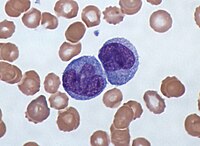
Photo from wikipedia
Background Sepsis is a fatal disease referring to the presence of a known or strongly suspected infection coupled with systemic and uncontrolled immune activation causing multiple organ failure. However, current knowledge… Click to show full abstract
Background Sepsis is a fatal disease referring to the presence of a known or strongly suspected infection coupled with systemic and uncontrolled immune activation causing multiple organ failure. However, current knowledge of the role of lncRNAs in sepsis is still extremely limited. Methods We performed an in silico investigation of the gene coexpression pattern for the patients response to all-cause sepsis in consecutive intensive care unit (ICU) admissions. Sepsis coexpression gene modules were identified using WGCNA and enrichment analysis. lncRNAs were determined as sepsis biomarkers based on the interactions among lncRNAs and the identified modules. Results Twenty-three sepsis modules, including both differentially expressed modules and prognostic modules, were identified from the whole blood RNA expression profiling of sepsis patients. Five lncRNAs, FENDRR, MALAT1, TUG1, CRNDE, and ANCR, were detected as sepsis regulators based on the interactions among lncRNAs and the identified coexpression modules. Furthermore, we found that CRNDE and MALAT1 may act as miRNA sponges of sepsis related miRNAs to regulate the expression of sepsis modules. Ultimately, FENDRR, MALAT1, TUG1, and CRNDE were reannotated using three independent lncRNA expression datasets and validated as differentially expressed lncRNAs. Conclusion The procedure facilitates the identification of prognostic biomarkers and novel therapeutic strategies of sepsis. Our findings highlight the importance of transcriptome modularity and regulatory lncRNAs in the progress of sepsis.
Journal Title: Journal of Translational Medicine
Year Published: 2020
Link to full text (if available)
Share on Social Media: Sign Up to like & get
recommendations!